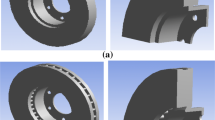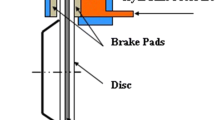Abstract
This study aims to analysis the thermo-mechanical behavior at dry contact between disc and pad during braking phase by computer simulation. The geometric design model of disc analyzed at transient temperature to embody the ventilation system in vehicle. Deformation, Von Mises stress and contact pressures at pad are investigated by coupled thermo-mechanical. These simulation results are satisfactorily verified by comparing with similar literature result. Thus, this study provides effective reference for design and engineering application of brake disc and brake pad.
Similar content being viewed by others
Abbreviations
- a :
-
Deceleration of the vehicle [ms−2]
- A d :
-
Disc surface swept by a brake pad [m2]
- g :
-
Acceleration of gravity (9.81) [ms−2]
- m :
-
Mass of the vehicle [kg]
- q0 :
-
Entering heat flux [W]
- v0 :
-
Initial speed of the vehicle [ms−1]
- z=a/g:
-
Braking effectiveness
- ɛp :
-
Factor load distribution on the disc surface
- ϕ :
-
Rate distribution of the braking forces between the front and rear axle
References
Bakar, A. R. A., Ouyang, H., Khai, L. C., and Abdullah, M. S., “Thermal Analysis of a Disc Brake Model Considering a Real Brake Pad Surface and Wear,” International Journal of Vehicle Structures & Systems, Vol. 2, No. 1, pp. 20–27, 2010.
Maleque, M. A., Adebisi, A. A., and Shah, Q. H., “Energy and Cost Analysis of Weight Reduction using Composite Brake Rotor,” International Journal of Vehicle Structures & Systems, Vol. 4, No. 2, pp. 69–73, 2012.
Lee, K. J. and Barber, J. R., “An Experimental Investigation of Frictionally-Excited Thermoelastic Instability in Automotive Disk Brakes Under a Drag Brake Application,” J. Tribol, Vol. 116, pp. 409–414, 1994.
Altuzarra, O., Amezua, E., Aviles, R., and Hernandez, A., “Judder vibration in disc brakes excited by thermoelastic instability,” Eng. comput, Vol. 19, No. 4, pp. 411–430, 2002.
Jang, Y. H. and Ahn, S. H., “Frictionally-excited thermoelastic instability in functionally graded material,” Wear, Vol. 262, pp. 1102–1112, 2007.
Yi, B. Y., Barber, J. R., and Zagrodzki, P., “Eigenvalue solution of thermoelastic instability problems using Fourier reduction,” Proc. R. Soc. London, A, Vol. 456, pp. 2799–282, 2000.
Nakatsuji, T., Okubo, K., Fujii, T., and Sasada, M., “Study on Crack Initiation at Small Holes of One-piece Brake Discs,” SAE Technical Paper, Vol. 66, No. 646, pp. 2016–2023, 2002.
Valvano, T. and Lee, K., “An Analytical Method to Predict Thermal Distortion of a Brake Rotor,” SAE Technical Paper, Vol. 109, No. 6, pp. 566–571, 2000.
Hudson, M. D. and Ruhl, R. L., “Ventilated Brake Rotor Air Flow Investigation,” SAE Technical Paper, Vol. 106, No. 6, pp. 1862–1871, 1997.
Denape, J. and Laraqi, N., “Aspect thermique du frottement: mise en évidence expérimentale et éléments de modélisation,” Mécanique & Industries, Vol. 1, No. 6, pp. 563–579., 2000.
Hamraoui, M., “Thermal behaviour of rollers during the rolling process,” Applied Thermal Engineering, Vol. 29, No. 11–12, pp. 2386–2390, 2009.
Hamraoui, M. and Zouaoui, Z., “Modelling of heat transfer between two rollers in dry friction,” Int. J. Therm. Sci., Vol. 48, No. 6, pp. 1243–1246, 2009.
Laraqi, N., “Velocity and relative contact size effect on the thermal constriction resistance in sliding solids,” ASME J. Heat Transf., Vol. 119, pp. 173–177, 1997.
Yapýcý, H., Genç, M. S., and Özýsýk, G., “Transient temperature and thermal stress distributions in a hollow disk subjected to a moving uniform heat source,” J. Therm. Stress., Vol. 31, pp. 476–493, 2008.
Laraqi, N., Alilat, N., de Maria, J. M., and Baïri, A., “Temperature and division of heat in a pin-on-disc frictional device — Exact analytical solution,” Wear, Vol. 266, No. 7–8, pp. 765–770, 2009.
Bauzin, J. G. and Laraqi, N., “Simultaneous estimation of frictional heat flux and two thermal contact parameters for sliding contacts,” Numerical Heat Transfer Part a-Applications, Vol. 45, No. 4, pp. 313–328, 2004.
Baïri, A., J. M. Garcia de Maria, n., and Laraqi, N., “Effect of thickness and physical properties of film on the thermal behavior of moving rough interfaces,” The European Physical Journal — Applied Physics, Vol. 26, No. 1, pp. 29–34, 2004.
Mijuca, D. M., iberna A. M., and Medjo B. I., “A new multifield finite element method in steady state heat analysis,” Therm. Sci. Vol. 9, No. 1, pp. 111–130, 2005.
Gao, C. H. and Lin, X. Z., “Transient temperature field analysis of a brake in a non-axisymmetric threedimensional model,” J. Materials Processing Technology, Vol. 129, pp. 513–517, 2002.
Talati, F. and Jalalifar, S, “Analysis of heat conduction in a disk brake system,” Heat and Mass Transfer, Vol. 45, No. 8, pp. 1047–1059, 2000.
Naji, M., Al-Nimr, M., and Masoud, S., “Transient thermal behavior of a cylindrical brake system,” Heat and Mass Transfer, Vol. 36, No. 1, pp. 45–49, 2000.
Mosleh, M., Blau, P. J., and Dumitrescu, D., “Characteristics and morphology of wear particles from laboratory testing of disk brake materials,” Wear, Vol. 256, No. 11–12, pp. 1128–1134, 2004.
Mutlu, I., Alma, M. H., Basturk, M. A., and Oner, C., “Preparation and characterization of brake linings from modified tannin-phenol formaldehyde resin and asbestos-free fillers,” Journal of Materials Science, Vol. 40, No. 11, pp. 3003–3005, 2005.
Hecht, R. L., Dinwiddie, R. B., and Wang, H., “The effect of graphite flake morphology on the thermal diffusivity of gray cast irons used for automotive brake discs,” Journal of Materials Science, Vol. 34, No. 19, pp. 4775–4781, 1999.
Gudmand-Høyer, L., Bach, A., Nielsen, G. T., and Morgen, P., “Tribological properties of automotive disc brakes with solid lubricants,” Wear, Vol. 232, No. 2, pp. 168–175, 1999.
Uyyuru, R. K., Surappa, M. K., and Brusethaug, S., “Tribological behavior of Al-Si-SiCp composites/automobile brake pad system under dry sliding conditions,” Tribology International, Vol. 40, No. 2, pp. 365–373, 2007.
Cho, M. H., Cho, K. H., Kim, S. J., Kim, D. H., and Jang, H., ’The Role of Transfer Layers on Friction Characteristics in the Sliding Interface between Friction Materials against Gray Iron Brake Disks,” Tribology Letters, Vol. 20, No. 2, pp. 101–108, 2005.
Boz, M. and Kurt, A., “The effect of Al2O3 on the friction performance of automotive brake friction materials,” Tribology International, Vol. 40, No. 7, pp. 1161–1169, 2007.
Blau, P. J. and McLaughlin, J. C., “Effects of water films and sliding speed on the frictional behavior of truck disc brake material,” Tribology International, Vol. 36, No. 10, pp. 709–715, 2003.
McPhee, A. D. and Johnson, D. A., “Experimental heat transfer and flow analysis of a vented brake rotor,” International Journal Thermal Sciences, Vol. 47, No. 4, pp. 458–467, 2008.
Wallis, L., Leonardi, E., Milton, B., and Joseph, P., “Air flow and heat transfer in ventilated disk brake rotors with diamond and teardrop pillars,” Numerical Heat Transfer Part A: Applications, Vol. 41, No. 6–7, pp. 643–655, 2002.
Johnson, D. A., Sperandei, B. A., and Gilbert, R., “Analysis of the Flow Through a Vented Automotive Brake Rotor,” Journal of Fluids Engineering, Vol. 125, No. 6, pp. 979–986, 2004.
Kang, S. S. and Cho, S. K., “Thermal deformation and stress analysis of disk brakes by finite element method Journal of Mechanical Science and Technology,” Vol. 26, No. 7, pp. 2133–2137, 2012.
Thilak, V. M. M., Krishnaraj, R., Sakthivel, M., and Kanthavel, K., Deepan marudachalam, M. G., Palani, R., “Transient thermal and structural analysis of the rotor disc of disc brake,” International Journal of Scientific & Engineering Research, Vol. 2, No. 8, 2011.
Lee, S. and Yeo, T., “Temperature and coning analysis of brake rotor using an axisymmetric finite element technique,” Proc. 4th Korea-Russia Int. Symp. On Science & Technology, Vol. 3, pp. 17–22, 2000.
Ouyang, H., Abu-Bakar, A. R., and Li, L., “A combined analysis of heat conduction, contact pressure and transient vibration of a disc brake,” International Journal of Vehicle Design, Vol. 51, No. 1, pp. 190–206, 2009.
Hassan, M. Z., Brooks, P. C., and Barton, D. C., “A predictive tool to evaluate disk brake squeal using a fully coupled thermomechanical finite element model,” International Journal of Vehicle Design, Vol. 51, No. 1, pp. 124–142, 2009.
Sivarao, M., Amarnath, M. S., Rizal, A. K., “An Investigation Toward Development Of Economical Brake Lining Wear Alert System,” International Journal of Engineering & Technology, Vol. 9, No. 9, pp. 251–256, 2009.
Kuciej, M. and Grzes, P., “The comparable analysis of temperature distributions assessment in disc brake obtained using analytical method and fe model,” Journal of kones powertrain and transport, Vol. 18, No. 2, 2011.
Cho, C. and Ahn, S., “Thermo-elastic analysis for chattering phenomenon of automotive disk brake,” KSME International Journal, Vol. 15, No. 5, pp. 569–579, 2001.
Jung, S. P., Kim, Y. G., and Park, T. W., “A Study on thermal characteristic analysis and shape optimization of a ventilated disc,” Int. J. Precis. Eng. Manuf., Vol. 13, No. 1, pp. 57–63, 2012.
Jung, S. P., Park, T. W., Jun, K. J., Yoon, J. W., Lee, S. H., and Chung, W. S., “A Study on the Optimization Method for a Multibody System using the Response Surface Analysis,” Journal of Mechanical Science and Technology, Vol. 23, No. 4, pp. 950–953, 2009.
Jung, S. P., Jun, K. J., Park, T. W., and Ahn, I. C., “An Optimum Design of a Gas Circuit Breaker Using Design of Experiments,” Mechanics Based Design of Structures and Machines, Vol. 36, No. 4, pp. 346–363, 2008.
Jung, S. P., Park, T. W., Yoon, J. W., Jun, K. J., and Chung, W. S., “Design Optimization of Spring of a Locking Nut using Design of Experiments,” Int. J. Precis. Eng. Manuf., Vol. 10, No. 4, pp. 77–83, 2009.
Jung, S. P., Park, T. W., and Chung, W. S., “Hot Judder Analysis of the Ventilated Disc Brake System of an Automotive,” Proc. KSME Autumn Conference, pp. 548–551, 2010.
Jung, S. P., Park, T. W., Chai, J. B., and Chung, W. S., “Thermomechanical finite element analysis of hot judder phenomenon of a ventilated disc brake system,” Int. J. Precis. Eng. Manuf., Vol. 12, No. 5, pp. 821–828, 2011.
Zhang, L., Yang, Q., Weichert, D., and Tan, N., “Simulation and Analysis of Thermal Fatigue Based on Imperfection Model of Brake Discs,” PAMM, Vol. 9, No. 1, pp. 533–534, 2009.
Cruceanu, C., Frâne pentru vehicule feroviare (Brakes for railway vehicles), Matrixrom, pp. 388, 2007.
Reimpel, J., “Technologie de freinage,” Vogel, 1998.
Gotowicki, P. F., Nigrelli, V., Mariotti, G. V., Aleksendric, D., and Duboka, C., “Numerical and experimental analysis of a pegs-wing ventilated disk brake rotor, with pads and cylinders,” 10th EAEC European Automotive Congress, 2005.
Versteeg, H. K. and Malalasekera, W., “An Introduction to Computational Fluid Mechanics: The Finite Volume Method,” Prentice Hall, 2nd Ed., 2007.
ANSYS, Ansys User Manual v.11, ANSYS, Inc., 1996.
Koetniyom, S., Brooks, P. C., and Barton, D. C., “The development of a material model for cast iron that can be used for brake system analysis,” Journal of Automobile Engineering, Vol. 216, No. 5, pp. 349–362, 2002.
Nouby, M. and Srinivasan, K., “Parametric Studies of Disc Brake Squeal using Finite Element Approach,” Jurnal Mekanikal, No. 29, pp. 52–66, 2009.
AbuBaker, A. R. and Ouyang, H., “Wear prediction of friction material and brake squeal using the finite element method,” Wear, Vol. 264, No. 11–12, pp. 1069–1076, 2008.
Tirovic, M. and Day, A. J., “Disc brake interface pressure distribution,” Journal of Automobile Engineering, Vol. 205, pp. 137–146, 1991.
Ouyang, H., Cao, Q., Mottershead, J. E., and Treyde, T, “Vibration and squeal of a disc brake: modelling and experimental results,” Journal of Automotive Engineering, Vol. 217, pp. 867–875, 2003.
Lee, Y. S., Brooks, P. C., Barton, D. C., and Crolla, D. A., “A predictive tool to evaluate disc brake squeal propensity Part 1: The model philosophy and the contact problem,” International Journal of Vehicle Design, Vol. 31, No. 289–308, 2003.
Author information
Authors and Affiliations
Corresponding author
Rights and permissions
About this article
Cite this article
Ali-Belhocine, Mostefa-Bouchetara Thermo-mechanical coupled analysis of automotive brake disc. Int. J. Precis. Eng. Manuf. 14, 1591–1600 (2013). https://doi.org/10.1007/s12541-013-0215-7
Received:
Accepted:
Published:
Issue Date:
DOI: https://doi.org/10.1007/s12541-013-0215-7




